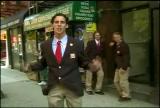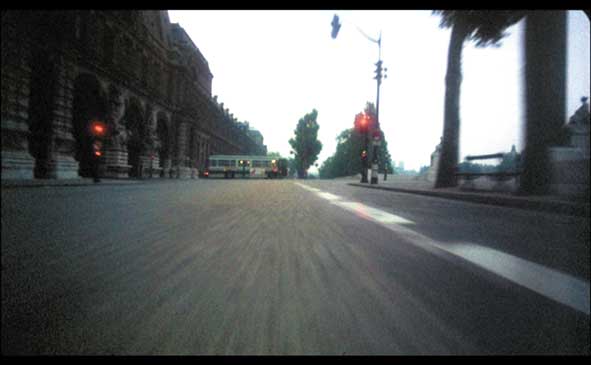Do whatever it takes. Kill the whole friggin’ space program. Put NASA out of business; my wife can find another job. Bankrupt the entire airline industry, and ground every plane. I don’t care.
Just please, Xeni, please stop it with the PR pablum from some zero-G plane that last made the news during the shooting of Apollo 11. It wasn’t interesting when Howard, Hanks & Bacon blabbed on about it, either, but at least they stopped after the movie came out. Unless you’re going to ride a on-loan-from-Marketing Segway in a parabolic arc, get off the plane; the flight landed a long time ago.
“Previous BB posts: 9, 8, 7, 6, 5, 4, 3, 2, 1.” [BoingBoing: Xeni Flies Zero-G #10]
Eros, Thanatos, Thanatos, Eros: Russ Meyer RIP
Faster Pussycat, Kill! Kill! director Russ Meyer went tits up over the weekend; students of his rather buxom body of work will recognize his fondness for this position.
My greatest Six Degrees of Kevin Bacon triumph was connecting FPKK‘s Tura Satana to Kevin Bacon, via Herve Villechaise, which was possible only with the help of the then-little-known IMDb.com.
Russ Meyer’s Obituary, with nice quotes from fan John Waters & screenwriter Roger Ebert [LA Times]
Try it yourself: Faster, Pussycat! [IMDb]
Don’t mess with her copyrights. Seriously. [TuraSatana.com]
More Thanatos, Please
 Speaking of Wong Kar Wai… Eros is a compilation of three great directors’ short films on the subject of, well, eros, love, and sex.
Speaking of Wong Kar Wai… Eros is a compilation of three great directors’ short films on the subject of, well, eros, love, and sex.
Early reports from Toronto say that Wong’s is the only segment that’s right. The others, by Steven Soderbergh and Michelangelo Antonioni, sound like a $5 handjob at the Port Authority and that 15 minutes window before the Spectravision hits your hotel room bill, respectively.
Apparently, the only reason to not leave after WKW’s short is the haunting Caetano Veloso song, “Michelangelo Antonioni,” which bridges the last two films. It’s a wonderful song, to be sure; I’d contemplated using it in the opening scene of my first short, but it was too heavy. I first replaced it with the Pink Floyd bongos from the opening of Antonioni’s Zabriskie Point.
I mention this because of the deep, meaningful connections between Soderbergh’s, Antonioni’s and my own work.
Wong Kar-Wai dominates uneven Eros [Peter Brunette, Indiewire]
According to the Italian producer’s site, the whole thing was producer Stephane Tchal Gadjieff and Antonioni’s trophy wife Enrica’s idea. [Fandango, no, not that Fandango]
The Nudist Buddhist, or Humping Sharon Waxman’s Leg
Whatever it takes to get the story, I guess. A serious shoutout to the Times’ Sharon Waxman, who had my boy David O. Russell [boxers, not that anyone asked] rub up against her on the set of I Heart Huckabee’s.
That’s the tip of the antics iceberg, though. Check out Waxman’s report covering the last 18 months of the production.
Interestingly, she’s very cagey about the finished product itself. She was very circumspect on the reactions at a cast/family/friends screening. Meanwhile, the film seems to be rocking ’em in Toronto.
The Nudist Buddhist Borderline-Abusive Love-In [Sharon Waxman, NYT]
Tom Hall ♥’s I ♥ H [Indiewire, via Greencine]
[9/22 Update: Defamer reports [sic] that D.O. is P.O.’ed about Waxman’s NYT article; seems he thought she was writing a book. Which, technically, is true. It’s called Rebels on the Backlot: Six Maverick Directors and How They Conquered the Hollywood Studio System.]
Correction: Explorateurs Urbains are NOT Cataphiles
My apologies for mistakenly calling the explorateurs urbains of La Mexicaine de Perforation cataphiles. In an interview on NPR, filmmaker Lazar Kunsman, the group’s spokesMexicain, explained that cataphiles are “more like nerds,” who just wander around underground without doing anything. Explorateurs, meanwhile, are seeking to produce new forms of creative expression, to create a viable, engaging alternative to the sterile, mainstream culture found aboveground.
So next time you run into a guy in the catacombs, just ask, “Why the hell did Harvey sit on Hero for so long?”
NPR interview with La Mexicaine de Perforation
Previous subterranean cinema posts, including a partial film programme
Bad Architecture (in Beijing)
China’s building boom may throw up a Rem Koolhaas now and then, but most of the time, it just looks like it’s throwing up.
Now, bad Chinese architecture has a home, BadJianZhu. Paul Wingfield, co-founder of the site, promises buildings with “a grandiose quality, a fantastical or monumental kind of aspiration that makes them worth recording.” Plus plenty of “Copies derived from copies, kitsch derived from kitsch.”
To be honest, a lot of it looks like the highway from DC to Dulles.
Visit BadJianZhu at badarchitecture.org
via Christopher Hawthorne’s NYT article, “Beijing’s Truly Bad Buildings”
Nice, Short Fresh Air Interview with Richard Kelly
Richard Kelly was on Fresh Air last week to discuss the director’s cut of Donnie Darko, which is platforming out into theaters now.
Who noted that theatrical re-release is fast becoming a standard marketing element for a remastered or new-version DVD?
Listen to Richard Kelly’s interview [9/7/04, 12 min., NPR]
Buy the old DVD version on Amazon, while supplies last [“Customers also bought Requiem for a Dream, Lost in Translation, Kill Bill and Pi“? Yeah, no kidding.]
RNC Thugz Videomakers Found, Speak
 Mission Accomplished (aka f***newyork, the name of the .mov file) was the hi-larious (so true, though, we’re only laughing on the outside) video of a gang of private school wiggaz telling it like it was about the RNC takeover of the city.
Mission Accomplished (aka f***newyork, the name of the .mov file) was the hi-larious (so true, though, we’re only laughing on the outside) video of a gang of private school wiggaz telling it like it was about the RNC takeover of the city.
While the rest of the world just sat back and laughed at it, the folks at hip hop music tracked down the film’s creators, writer Sam Marks and director Max Rockatansky (aka Matt Lenski) for an interview. It’s great stuff, even if they do use the N-word. And the F-word. And a bunch of other words. A lot.
The Guys Behind the F***NewYork Video [hiphopmusic.com]
Google “f***newyork.mov”, but not with asterisks to find the file.
[via Anil]
Now THAT’S a Health Care Crisis
“As for her walking barefoot, The Doctor’s orders are for her to wear Uggs or tennis shoes and it’s just too hot for that.”
Uggs? Uggs??? You might as well bleed her to rebalance her humeurs. Mrs. Spears.
[via Defamer, who keeps track of Britney’s toilet footwear so you don’t have to. Unless you work for InStyle, in which case, it’s your job, and what your parents shelled out $140,000 so you could go to Brown for. They must be so proud.]
And you thought THX 1138 was dystopic
“At one point, when we saw him, he was modestly introducing himself to ELEANOR COPPOLA.
“‘Hi, I’m Jim Caviezel,’ he said. ‘I played Jesus in The Passion of the Christ.‘
“Then they talked, appropriately enough, we thought, about wine.”
– Boldface Names report from the THX 1138 party at the Guggenheim, NYT 09/16/04
A Hen in the Foxhouse
Arist Monica Bonvicini will participate in a panel discussion at Art Forum Berlin, the giant art fair, next week. Her co-panelists: gallerist Joe Amrhein, and collectors Harald Falckenberg and Mera & Don Rubell. The moderator is Marc Spiegler, an srt writer who made this sort of trouble at Basel, too.
The Topic: “Bigger! Faster! Out of control! Does today’s Art Market devour Artists?”
From the description: “Since the early 1990s, the art market has been rocked by change. There are many more collectors today, buying more aggressively. The role of the gallery is being radically transformed (and even threatened) by the surging number of fairs, biennials and contemporary auctions. Artists are treated like popstars and their audience often suffers from Neophilia, a constant craving for the new…Is this a permanent transformation or just a ‘Live Fast, Die Young’ phenomenon, dooming us for a crash and destined to yield only ephemeral art?”
Be sure to bring a pen (to jot down the names of hot new artists) and your checkook. Art Forum Berlin, 9/21 @ 1730 (that’s 5:30 to you, pal)
Aaron Eckhart IS Samson IN The Grizzly Adams Production OF
The Bible’s Greatest Miracles. Yes, before he donned a wig in Erin Brockovich, but after his breakout performances in Neil Labute’s In The Company of Men and Your Friends and Neighbors (and a supporting role in Oliver Stone’s Any Given Sunday), Aaron Eckhart, sporting a wig that must have required a lot of faith, played an almost Stoppardian Samson in this 1999 made-for-PaxTV documentary.
I remember stopping dead in my channel surfing tracks when I saw my former BYU classmate, New York neighbor and fellow parishioner, and ex-boyfriend of my good friend, doing an Old Testament John Wayne on what looked like the Egyptian set of Dr. Who. My kingdom for a video capture.
But don’t just take my word for the power of this film. Grizzly Adams witnesses best:
History’s most spectacular miracles and claims. . .but are they true? Bible scholars and skeptics examine four of the Bible’s greatest mysteries–David and Goliath; Moses receiving the Ten Commandments on Mt. Sinai; Shadrach, Meshach, and Abednego in the fiery furnace; and the story of strongman Samson and Delilah–to determine if they are myth or reality. Watch dramatic re-creations of Bible events, expert testimony, and conclusive scientific experiments that put these Bible stories to the test. See compelling new evidence that the Bible is indeed factual and trustworthy!
Bonus: the script was written by David Balsiger, who just wow’ed em in Dallas.
Buy The Bible’s Greatest Miracles on DVD, direct from Grizzly Adams Productions, for $19.95.
And That’s How Grizzly Adams Got His G-Class
What’s with all the film festivals this time of year (Venice, Telluride, Toronto, NY, American Film Renaissance)? If you haven’t heard of that last one, [Their slogan: “Doing films the right way”] for heaven’s sake don’t tell anyone; they’ll know you’re not one of them.
AFR is a conservative film festival full of true believers; Bryan Curtis, who must’ve drawn the short festival coverage straw over at Slate, does a bangup job of unpacking the messages of this obscure, oppressed, voiceless underclass.
After laughing endlessly at cruel Michael Moore fat jokes, Curtis reports how the crowd grew uneasy and confused at David Balsiger’s screening. The head of Grizzly Adams productions, Balsiger greenlighted his company’s latest film, on George Bush’s faith, after commissioning Gallup polls on what’s hot with big swaths of Middle America. Yay, Capitalism? Wha? You’d think these people hadn’t seen Austin Powers.
Sundance for Republicans [Bryan Curtis, Slate]
American Film Renaissance [what, no invocation?]
Grizzly Adams film and television
C’Etait Un Rendezvous: a pure Parisian chase movie

And I thought Ronin had the most jaw-dropping Parisian car chase scene.
In August 1976, French director Claude Lelouch (who, it turns out, did the French segment of 11″09’01, the one where the deaf chick decides to break up with her boyfriend at 9:59 or something) had 9 minutes of film, a Ferrari 275 GTB, a gyro-stabilized camera and mount, and an idea.
He set a route through the center of Paris, from Porte Dauphine, through the Louvre and up to the Basilica of Sacre Coeur, strapped the camera on the bumper, and drove flat out through the (somewhat empty) early morning streets.
Rendezvous is the one-take artifact of that insane and illegal trip. Not technically a chase scene, maybe it should be called a race scene. It’s the verite equivalent of the Hollywood-staged Sunset Blvd race in Against All Odds, and it ranks with the likes of Peter Yates’ Bullitt and Friedkin’s The French Connection for best car chase scenes ever.
With one difference: the obvious danger to bystanders during Rendezvous throws peoples’ moral compasses out of whack. Some, like neonrebel, get all hot for the film, then suddenly turn all critical and judgmental, like a self-hating preacher after scoring a hooker. Others, like a writer for The Daily Express, show amazing lack of judgment when he calls the film “an automotive equivalent of September 11th footage.”
Now you, too, can hate yourself in the morning; after decades underground, C’Etait Un Rendezvous is now available on DVD.
Buy Spirit Level Film’s release of Rendezvous for $28.95 from Chasecam. Read neonrebel’s review. [via the Sachs Report? Why didn’t you tell me about him before?]
[9/17 update: Lelouch has performed another stunt this week, offering free nationwide screenings for his latest film, Les Parisiens, which got panned by critics.]
Bloghdad.com/Gunner_Palace
Tony Scott’s first report from Toronto really gives you a feel for the festival’s sprawl and cinematic frenzy, where you feel like you’re missing movies more than watching them. Meanwhile, he only mentions one film, and he mentions the hell out of it: Gunner Palace, Mike Tucker and Petra Epperlein’s documentary about US soldiers’ lives in Baghad. Here’s a taste:
Gunner Palace is so startling because it suggests – it shows – just how complicated the reality of this war has been. It may not change your mind, but it will certainly deepen your perception and challenge your assumptions, whatever they may be. I hope “Gunner Palace” makes its way quickly from this festival to American theaters, because it is not a movie anyone should miss.
Sure, but did you like it?
Sex, War, and Hype at Toronto Festival of Films [A.O. Scott, NYT]
See a trailer and clips at GunnerPalace.com
